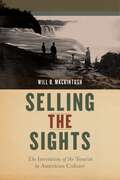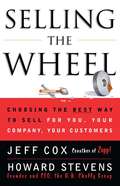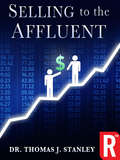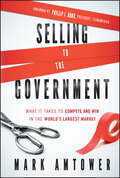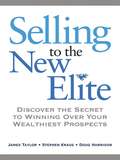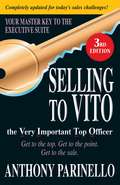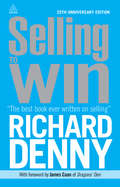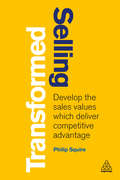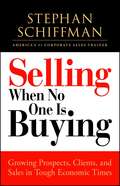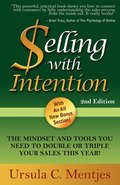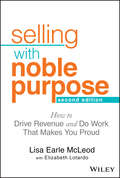- Table View
- List View
Selling the Sacred: Religion and Marketing from Crossfit to QAnon
by Mara Einstein Sarah McFarland TaylorThere’s religion in my marketing! There’s marketing in my religion! Selling the Sacred explores the religio-cultural and media implications of a two-sided phenomenon: marketing religion as a product and marketing products as religion. What do various forms of religion/marketing collaboration look like in the twenty-first century, and what does this tell us about American culture and society?Social and technological changes rapidly and continuously reframe religious and marketing landscapes. Crossfit is a “cult.” Televangelists use psychographics and data marketing. QAnon is a religion and big business. These are some of the examples highlighted in this collection, which engages themes related to capitalist narratives, issues related to gender and race, and the intersection of religion, politics, and marketing, among other key issues.The innovative contributors examine the phenomenon of selling the sacred, providing a better understanding of how marketing tactics, married with religious content, influence our thinking and everyday lives. These scholars bring to light how political, economic, and ideological agendas infuse the construction and presentation of the “sacred,” via more traditional religious institutions or consumer-product marketing. By examining religion and marketing broadly, this book offers engaging tools to recognize and unpack what gets sold as “sacred,” what’s at stake, and the consequences.A go-to resource for those working in marketing studies, religious studies, and media studies, Selling the Sacred is also a must-read for religious and marketing professionals.
Selling the Sea: An Inside Look at the Cruise Industry
by Bob Dickinson Andy VladimirAn insider's view of how the cruising business operates. "Selling the Sea" offers a complete picture of the cruise line industry along with step-by-step coverage of how to effectively market the cruising experience. This updated "Second Edition" features new coverage of how technology has impacted the industry, new niche markets in cruising, and expanded material on shipbuilding and design. It also includes insightful interviews with today's captains, social directors, food and beverage managers, and cruise line executives who have hands-on experience at the day-to-day workings of a cruise ship. Bob Dickinson is President and CEO of Carnival Cruise Lines and a member of the Board of Directors of the parent company Carnival Corporation. Andy Vladimir is a well-known business and travel writer, a member of the Editorial Board of the FIU Hospitality Review, and contributing editor of Quest magazine.
Selling the Sights: The Invention of the Tourist in American Culture (Early American Places #16)
by Will B. MackintoshA fascinating journey through the origins of American tourismIn the early nineteenth century, thanks to a booming transportation industry, Americans began to journey away from home simply for the sake of traveling, giving rise to a new cultural phenomenon —the tourist.In Selling the Sights, Will B. Mackintosh describes the origins and cultural significance of this new type of traveler and the moment in time when the emerging American market economy began to reshape the availability of geographical knowledge, the material conditions of travel, and the variety of destinations that sought to profit from visitors with money to spend. Entrepreneurs began to transform the critical steps of travel—deciding where to go and how to get there—into commodities that could be produced in volume and sold to a marketplace of consumers. The identities of Americans prosperous enough to afford such commodities were fundamentally changed as they came to define themselves through the consumption of experiences.Mackintosh ultimately demonstrates that the cultural values and market forces surrounding tourism in the early nineteenth century continue to shape our experience of travel to this day.
Selling the Welfare State: The Privatisation of Public Housing (Routledge Revivals)
by Ray Forrest Alan MurieOriginally published in 1988, this book offers the first comprehensive and critical analysis of the privatisation of public housing in Britain. It outlines the historical background to the growth of public housing and the developing political debatea surrounding its disposal. The main emphasis in the book, however, is on the ways in which privatisation in housing links to other key changes in British society. The long trend for British social housing to become a welfare housing sector is related to evidence of growing social polarisation and segregation. Within this overall context, the book explores the uneven spatial and social consequences of the policy.
Selling the Wheel: Choosing the Best Way to Sell For You, Your Company, and Your Customers
by Jeff Cox Howard StevensSelling the Wheel is a fascinating story about sales and marketing written in the form of an ancient parable: Once upon a time, long ago, a resourceful fellow named Max came up with a brilliant idea and invented the Wheel. But human beings, who had been getting along without the Wheel for thousands of years, did not instantly appreciate their need for this clever invention.... This is the challenge facing Max, as dramatized by Jeff Cox, coauthor of the bestselling business novels Zapp! and The Goal, Selling the Wheel is based on the pioneering research of Howard Stevens's employment-testing and customer-research firm, the H. R. Chally Group. In the story, Max and his wife, Minnie, learn what it takes to market the Wheel. With the help of Ozzie the Oracle, they discover four essential selling styles -- Closer, Wizard, Relationship Builder, and Captain & Crew -- and come to understand how each style is suited to a different type of salesperson. They learn that as markets evolve, selling styles and strategies must change. There is no single right way -- and no company can be all things to all people. This critical lesson is as valuable to salespeople as it is to sales managers. Writer Jeff Cox has the amazing gift for translating technical ideas into creative, engaging stories, and his collaboration with sales and marketing expert Howard Stevens is based on empirical research collected from 250,000 salespeople, more than 1,500 people in corporate sales, and interviews with more than 100,000 actual customers who rated the strengths and weaknesses of the salespeople serving them. Packed with practical tips for salespeople, entrepreneurs, marketing managers, and business students, Selling the Wheel is an irresistible guide to sales styles, strategies, and markets.
Selling Through Someone Else: How to Use Agile Sales Networks and Partners to Sell More
by Robert Wollan Michael Heald Naveen JainExperience the growth multiplier effect through transforming the distribution and sales network Selling Through Someone Else tackles new opportunities to drive company growth by taking a fresh look at the customer smart distribution and sales process.<P><P> The authors, from Accenture, one of the world's largest consulting companies, explain how companies can be smarter about what their customers truly want and maximize the return on investment from all available resources for growth opportunities by exploring creative distribution options, including leveraging partners, online outlets, iPads/tablets, your traditional sales force, and more. Selling <P>Through Someone Else demonstrates that traditional approaches are no longer effective and how, by capitalizing on converging forces, companies can transform their "sales" approaches to grow revenue, and enhance customer and brand loyalty. Explores how globalization, new competitors, and low-cost threats are reshaping the way sales is happening today, and how to prepare your company to be successful in this new dynamic and iterative selling model Shows how analytics, the shift to digital selling and mobile sales tools, and new approaches to sales operations can reshape the entire sales function Demonstrates how new ecosystems of partners are created, managed, and incented to drive greater sales and profitability Accenture has helped numerous clients collaborate across IT, Sales, and Marketing to dramatically grow distribution and adapt to the different "playing field" of today. Selling through Someone Else applies the trends and lessons learned from Fortune 500 and Global 500 companies to mid-sized enterprises and small-medium businesses owners.
Selling to Anyone Over the Phone: Connect With Every Customer; Generate Better Leads; Close More Sales
by Renee P. Walkup Sandra MckeeIn a clear, friendly tone, Selling to Anyone over the Phone shows sellers how to develop exceptional phone skills and close more sales faster. Few sales professionals have ever had any training in how to sell over the phone; this book will help them build rapport, generate excitement about a product and more.
Selling to China: Stories of Success, Failure, and Constant Change
by Ker D. GibbsThis book, authored by the head of the American Chamber of Commerce in Shanghai during the US-China trade war, is a sobering look at the realities of the intermeshed nature of the Chinese and American economies at a time of increasing political tension. Foreign companies are caught in the middle between compliance with US laws and policies versus doing what’s required to have support in China and access to the world’s largest growth market. Opportunities still exist, but this is a dangerous and complicated time. This book will be of interest to professionals, economists, and scholars of US-China relations.
Selling to the Affluent: The Professional's Guide To Closing The Sales That Count
by Dr. Thomas J. StanleyFrom the New York Times–bestselling coauthor of The Millionaire Next Door: &“No one better illuminates the who, where, and how of the affluent market&” (J. Arthur Urciuoli, former chairman at Merrill Lynch). In the bestselling classic The Millionaire Next Door, Dr. Thomas J. Stanley showed his readers where to look for the wealthy. In Selling to the Affluent, he shows us how to persuade them. This book provides an insightful roadmap of the motivations and purchasing patterns of the affluent—and delivers a strategy for salespeople to leverage that information to the best advantage. This book outlines all phases of the sales process, from approaching wealthy prospects to pinpointing their wants and needs—frequently different from those of less affluent markets—and selling both tangible and intangible products. It profiles several key demographics within the wealthy subset—including business owners, men and women, and the retired. It&’s the most detailed and inclusive manual on the market for selling to the wealthy. &“Dr. Stanley&’s strategies consider the real needs of the high income professionals—needs that go beyond any product or service. These needs are psychological and revolve around the recognition of the individual&’s extraordinary level of achievements. He provides some terrific insights as to how to solicit and maintain business by unconventional, but highly effective means.&” —Carolyn J. Cole, chairman and founder of The Cole Group and The institute of Economics and Finance &“Selling to the Affluent is well written, relevant, and exciting; it presents an important complementary extension to Marketing to the Affluent.&” —William D. Danko, PhD, coauthor of The Millionaire Next Door
Selling to the Affluent: The Professional's Guide to Closing the Sales that Count
by Thomas J. StanleyTom Stanley explains the mindset and buying patterns of wealthy individuals showing sales people how to approach this enormously attractive market, open doors, appeal to the "hot buttons" of the affluent, and sell to extremely successful people. He provides insights into different affluent groups.
Selling to the Government
by Mark AmtowerLearn the crucial ins and outs of the world's largest marketThe U.S government market represents the largest single market--anywhere. Government contract tracking firm Onvia estimates that government business--federal, state, local, and education--represents better than 40 percent of the nation's GDP. While anyone can play in this market, only those with the right preparation can win.Selling to the Government offers real-world advice for successful entry into the biggest market anywhere. Get proven approaches, strategies, tactics, and tools to make your business stand out, build relationships, understand procedures, and win high-stakes contracts. * Every year thousands of companies enter the massive U.S. Government (BtoG) marketplace, and by the end of the first year, most are gone and less than 10 percent make it to year two * Author has advised hundreds of companies, including Apple, Dell, CDW, Northrop Grumman, General Dynamics, IT, GTSI, and many small firms, on all aspects of marketing and selling to the governmentFrom the go/no-go decision, through company infrastructure requirements, marketing, sales, business development, and more, this book offers the best advice from the most recognized authority in the market.
Selling to the New Elite: Discover the Secret to Winning Over Your Wealthiest Prospects
by Jim Taylor Stephen Kraus Doug HarrisonBased on unprecedented research, The New Elitetook a behind-the-scenes look at America's most powerful and influential class - what motivates them, how they think, where they shop, and how they really spend their money. In this practical and fascinating follow-up, the authors reveal how salespeople and marketers can hone in on this wealthy class, pique their interest, and convert them into loyal customers. Presenting the best practices behind hundreds of mutually satisfying interactions between salespeople and buyers - based on studies of elite companies such as Lexus, Chanel, Neiman Marcus, Four Seasons, Cartier, and Louis Vuitton - Selling to the New Elitereveals what the truly rich want from brands, what they expect from the marketplace, and how the Great Recession has reshaped their purchasing patterns. Loaded with insight and indispensable techniques, this one-of-a-kind guide shows readers everywhere how they can win over the wealthiest customers. . . and become rich themselves.
Selling To Vito: The Very Important Top Officer
by Anthony ParinelloSelling to Vito contains all the tactics you need to get appointments with impossible-to-reach top decision-makers. They in fact are the Very Important Top Officers (VITOs), the people with the ultimate veto power who hold the key to bigger commission checks, every sales award you could possibly win, and VITO to VITO referrals that you can take to the bank!You'll quickly learn how to:Get into new accounts at the topKeep out of time-consuming log-jams-and into VITO's officePromote loyalty at the top with existing customers and capture add-on businessIncrease the size of every saleSelling To VITO offers innovative new ideas and street-smart tactics for reaching the very top person in any organization. It's based on the seminars that have helped thousands of sales professionals from top corporations like Canon, 3M, Hewlett-Packard, and MCI bust quotas and increase commissions. It can help you, too, by getting you to the right person so you can do what you do best: SELL!Anthony Parinello is without question the country's foremost expert on getting appointments with, and selling to, top decision makers. This book is the product of his twenty-three years of award-winning sales performance.
Selling to VITO the Very Important Top Officer: Get to the Top. Get to the Point. Get to the Sale.
by Anthony ParinelloMaximize your sales abilities with this easy-to-follow, step-by-step guide to boost your sales career.There has never been a sales book that gives you one-on-one, personal help to catapult your sales career and your personal income to a level that will surprise you and shock your sales manager! You&’ll stop: -Wasting your precious selling time with &“non-decision&” makers -Getting any rejection whatsoever from gatekeepers -Working your keester off for itsy, bitsy sales -Losing sales that you thought you were going to win -Not making your sales quota You&’ll start: -Making sales that are up to 65 percent bigger -Cutting your sales cycle in half -Getting as much as 120 percent more add-on business from your existing customers -Getting VITO to VITO referrals worth pure gold -Making the income that you really deserve Take your sales career to the next level with these tips and tricks sure to selling anything!
Selling to Win
by Richard DennyRichard Denny is the "godfather of salesmanship" and Selling to Win has established itself as an international best-seller and classic sales text. One of the world's most inspirational business speakers, Richard has helped countless thousands of salespeople to become high flyers, and in this bestselling book he explains how to put his winning techniques into action. This 25th anniversary edition of Selling to Win has been fully revised and updated and is packed with even more unbeatable sales tips. You'll find tried and tested advice on how to: get a sale when you are not the cheapest; beat the competition; turn your customer into an ambassador; build a positive attitude that gets results; close a sale. Recognized worldwide as one of the most effective and powerful sales-improvement guides ever written, Selling to Win is the salesperson's bible.
Selling Today: Partnering to Create Value
by Michael Ahearne Barry Reece Gerald ManningUtilize cutting-edge personal selling techniques to navigate the information revolution era, Selling Today: Partnering to Create Value helps you understand the value of developing personal selling skills by exposing you to a personal selling academic theory, role play scenarios, and real-world applications and ethical dilemmas. <p><p>With the largest number of “learn by doing” materials available in any personal selling text, the 14th Edition offers tools to strengthen your learning process. As the developed nations of the world transition from a production focus to a sales-and-service focus, this cutting-edge new edition prepares you to succeed as a member of a new generation of businesspeople.
Selling Tourism Services at a Distance
by Josep Maria Bech SerratNew rules on distance contracts provided for the Consumer Rights Directive of 25 October 2011 do not apply to package holidays or contracts falling within the scope of the Timeshare Directive. Moreover, contracts for passenger transport services and contracts for the provision of accommodation, car rental, catering or leisure services if the contract provides for a specific date or period of performance are not covered by some of these rules. Yet measures aimed at protecting the consumer when a contract is concluded via the phone, the Internet, by mail or other means of distance communication play a role in tourism. This book helps readers to navigate through uncertainties in travel contracts regarding information requirements, the right of withdrawal or providing alternative services. Findings reveal that consumer acquis is inadequately adapted to the features of the tourism industry when an optional instrument based on the Draft Common Frame of Reference might be used in the future.
Selling Transformed: Develop the Sales Values which Deliver Competitive Advantage
by Philip SquireFor years, sales people have struggled with cliched views of how they sell, while at the same time customers have become more sophisticated and discerning, stopping off at different or unconventional places in the sales funnel. The result is that the technique of sales people controlling the sales conversation and learning how to influence the customer no longer works. Selling Transformed introduces the new world of selling, and addresses the reasons why sales people are so poorly perceived. Selling Transformed provides fresh, tangible ideas on how to develop better sales practices. Focusing as much on the customers as on the sellers, it explains key theories of selling effectively and introduces four proven strategies that are based on the values customers look for in sales people: authenticity, client-centricity, proactive creativity and being tactfully audacious. Explaining what customers look for in sales people, and advising on how to develop and deliver these values, this is a new type of sales manual guaranteed to improve sales performance.
Selling under the Swastika: Advertising and Commercial Culture in Nazi Germany
by Pamela E. SwettSelling under the Swastika is the first in-depth study of commercial advertising in the Third Reich. While scholars have focused extensively on the political propaganda that infused daily life in Nazi Germany, they have paid little attention to the role played by commercial ads and sales culture in legitimizing and stabilizing the regime. Historian Pamela Swett explores the extent of the transformation of the German ads industry from the internationally infused republican era that preceded 1933 through the relative calm of the mid-1930s and into the war years. She argues that advertisements helped to normalize the concept of a "racial community," and that individual consumption played a larger role in the Nazi worldview than is often assumed. Furthermore, Selling under the Swastika demonstrates that commercial actors at all levels, from traveling sales representatives to company executives and ad designers, enjoyed relative independence as they sought to enhance their professional status and boost profits through the manipulation of National Socialist messages.
Selling Used Books Online: The Complete Guide to Bookselling at Amazon's Marketplace and Other Online Sites
by Stephen Windwalker Genevieve KazdinDiscusses how to get started selling used books online, with an emphasis on amazon.com. Also covers the basics of starting and running a business.
Selling When No One is Buying
by Stephan SchiffmanTimes are tough all over. Wall Street is shivering and consumer confidence is dropping like a rock. Yet it's possible for the enterprising salesperson to still gain prospects, sign new clients, and close the deal. All it takes is persistence, energy, some new thinking, and the advice of Stephan Schiffman, American's top corporate sales trainer. Schiffman shows you how to: Treat customers individually Make life easier for customers in bad times Show that bad times won't last forever Reorient their thinking now to prepare for the future Across America, the sales landscape is changing swiftly. But even in an economic downturn, salespeople can survive--and thrive! The key to success is to learn how to sell when no one is buying.
Selling When No One is Buying: Growing Prospects, Clients, and Sales in Tough Economic Times
by Stephan SchiffmanTimes are tough all over. Wall Street is shivering and consumer confidence is dropping like a rock. Yet it's possible for the enterprising salesperson to still gain prospects, sign new clients, and close the deal. All it takes is persistence, energy, some new thinking, and the advice of Stephan Schiffman, American's top corporate sales trainer. Schiffman shows you how to:Treat customers individuallyMake life easier for customers in bad timesShow that bad times won't last foreverReorient their thinking now to prepare for the future Across America, the sales landscape is changing swiftly. But even in an economic downturn, salespeople can survive-and thrive! The key to success is to learn how to sell when no one is buying.
Selling When No One is Buying
by Stephan SchiffmanTimes are tough all over. Wall Street is shivering and consumer confidence is dropping like a rock. Yet it's possible for the enterprising salesperson to still gain prospects, sign new clients, and close the deal. All it takes is persistence, energy, some new thinking, and the advice of Stephan Schiffman, American's top corporate sales trainer. Schiffman shows you how to: Treat customers individually Make life easier for customers in bad times Show that bad times won't last forever Reorient their thinking now to prepare for the future Across America, the sales landscape is changing swiftly. But even in an economic downturn, salespeople can survive'and thrive! The key to success is to learn how to sell when no one is buying.
Selling with Intention: The Mindset and Tools You Need to Double or Triple Your Sales This Year
by Ursula C. MentjesEvery Sales Person and Entrepreneur knows that selling is the key to success, but most never achieve their potential even after attending numerous trainings and reading dozens of books. Why? Most of the training industry focuses on technique without ever addressing the most important part of the sales process – what the Sales Person is saying to themselves. It doesn’t matter how well you implement the concepts and methods if you haven’t addressed the beliefs and behaviors that are sabotaging your efforts. “How we think about selling makes all the difference.” In Selling With Intention, Sales Expert and Certified Sales Coach Ursula Mentjes shares the expertise she uses to help clients double their sales revenues in as short as two months. Her principles and exercises will help you: Transform the way you think about and interact with your target clients, the sales process, and yourself as a sales person; Develop the mindset, systems, and intentional sales plan you need to significantly increase sales; Let go of the fears and limiting beliefs that have been sabotaging your efforts; Move forward with a renewed sense of confidence in solving clients’ problems; and Take a quantum leap toward your greatest sales goals.
Selling With Noble Purpose: How to Drive Revenue and Do Work That Makes You Proud
by Lisa Earle McLeodDon’t let anyone tell you that you have to choose between making money and making a difference. Selling With Noble Purpose: How to Drive Revenue and Do Work That Makes You Proud, 2nd Edition is an update of the acclaimed book that changed the game in sales. Using real-world data, compelling stories and psychological research, Selling With Noble Purpose explains why salespeople who genuinely understand how they can make a difference to customers outsell those who only focus on internal targets and quotas. Sales leadership experts McLeod and Lotardo reveal how a Noble Sales Purpose (NSP) can drive a team to outstanding sales numbers. Whether you’re an executive, manager or aspiring sales leader, you’ll discover how to find your own Noble Sales Purpose and create a sales force of True Believers. This new edition covers: How firms overcome ferocious competition and how you can do the same Why sales organizations with a clear NSP outperform traditional sales teams How to avoid the trap of behaving like a transactional salesperson Why well-intended leaders often unknowingly erode purpose and differentiation How to use your NSP to increase customer engagement Why an NSP gives you clarity during times of uncertainty In an era where organizations often believe that money is the primary way to motivate salespeople, Selling with Noble Purpose offers and exciting and sustainable alternative.


